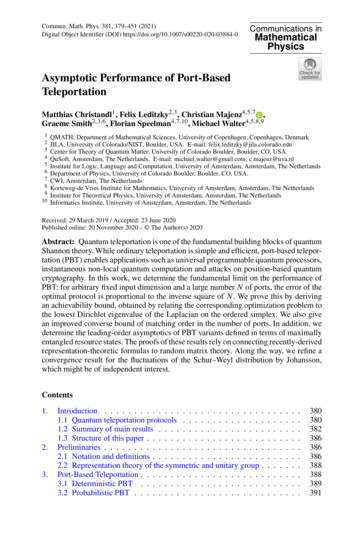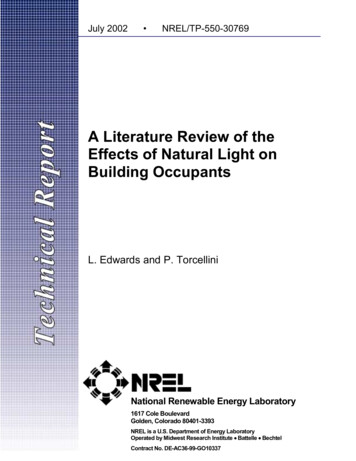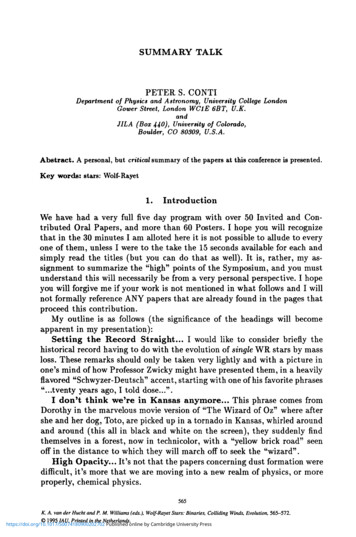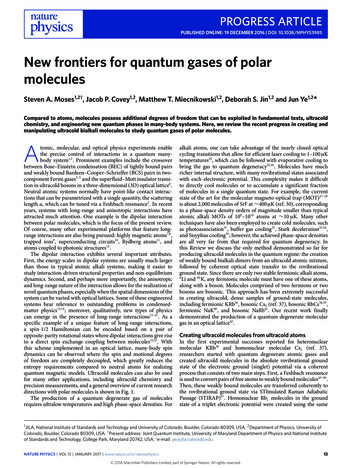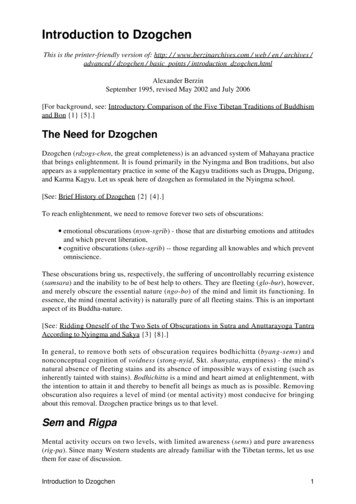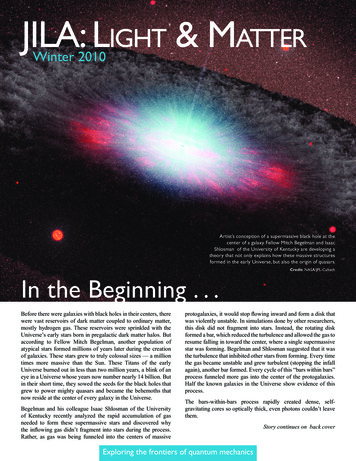
Transcription
JILA: Light & MatterWinter 2010Artist’s conception of a supermassive black hole at thecenter of a galaxy. Fellow Mitch Begelman and IsaacShlosman of the University of Kentucky are developing atheory that not only explains how these massive structuresformed in the early Universe, but also the origin of quasars.Credit: NASA/JPL-CaltechIn the Beginning . . .Before there were galaxies with black holes in their centers, therewere vast reservoirs of dark matter coupled to ordinary matter,mostly hydrogen gas. These reservoirs were sprinkled with theUniverse’s early stars born in pregalactic dark matter halos. Butaccording to Fellow Mitch Begelman, another population ofatypical stars formed millions of years later during the creationof galaxies. These stars grew to truly colossal sizes — a milliontimes more massive than the Sun. These Titans of the earlyUniverse burned out in less than two million years, a blink of aneye in a Universe whose years now number nearly 14 billion. Butin their short time, they sowed the seeds for the black holes thatgrew to power mighty quasars and became the behemoths thatnow reside at the center of every galaxy in the Universe.Begelman and his colleague Isaac Shlosman of the Universityof Kentucky recently analyzed the rapid accumulation of gasneeded to form these supermassive stars and discovered whythe inflowing gas didn’t fragment into stars during the process.Rather, as gas was being funneled into the centers of massiveprotogalaxies, it would stop flowing inward and form a disk thatwas violently unstable. In simulations done by other researchers,this disk did not fragment into stars. Instead, the rotating diskformed a bar, which reduced the turbulence and allowed the gas toresume falling in toward the center, where a single supermassivestar was forming. Begelman and Shlosman suggested that it wasthe turbulence that inhibited other stars from forming. Every timethe gas became unstable and grew turbulent (stopping the infallagain), another bar formed. Every cycle of this “bars within bars”process funneled more gas into the center of the protogalaxies.Half the known galaxies in the Universe show evidence of thisprocess.The bars-within-bars process rapidly created dense, selfgravitating cores so optically thick, even photons couldn’t leavethem.Exploring the frontiers of quantum mechanicsStory continues on back cover
First LightThe merger of supermassive black holes is a hot topic inastrophysics. Such mergers may occur after the formation ofblack hole binaries during galaxy collisions. The mergers arepredicted to emit gravitational waves, whose detection is themission of the Laser Interferometer Space Antenna (LISA). Inpreparation for the LISA mission, which is scheduled for launchin 2018, Fellow Peter Bender is working with colleagues aroundthe world to improve LISA’s design (see JILA Light & Matter,Summer 2006).In the meantime, FellowPhil Armitage wants toknow whether black-holemergers could also emit light(of any wavelength in theelectromagnetic spectrum). Ifblack-hole mergers do emitlight just before or right afterthe black holes coalesce, thenother space observatoriesmight be able to scan for themergers, too. Alternatively, iflight emission due to mergersoccurs, but is weak, otherspace observatories couldfocus their telescopes onnewly coalesced black holesonce they have been identifiedby LISA.Newsimulationshaverecently given scientists abetter understanding of thecircumstances that could leadto emission of light duringa black hole merger. Thesimulations were performedby former research associateElena Rossi (now at the HebrewUniversity in Jerusalem),Armitage, and their colleaguesat the Università degli Studidi Milano, the Universityof Leicester, and the UK’sInstitute of Astronomy.Nanomeasurement is a Matter ofthe Utmost Precisionpredicted luminosity from disks around massive recoiling blackholes appears to be far smaller than previously thought.Here’s why: According to the simulations, the amount of lightthat would be emitted by “low-mass” merging black holes (withmasses equal to 1 million suns) would be large only if threeconditions were satisfied: (1) if the recoil velocity caused by theemission of gravitational waves during the merger is at least 1000km/s; (2) if the recoil, or kick, occurs close to the plane of the diskof gas surrounding themerging black hole, and(3) if the surroundingdisk’s mass is largeenough.The third conditionis the problem. Theinteraction of the diskwith merging blackholes probably doesgenerate either X-raysor infrared light. But, atthe large distances fromthe black hole wheremost of the light isemitted, a massive diskwould likely fragmentinto stars that are almostunaffectedbythemerger. And a low-massdisk doesn’t add enoughlight to the total tocreate a flare that wouldbe noticeable among thestars and galaxies.Simulation of gravitational radiation from the merger of two blackholes. After the Laser Interferometer Space Antenna (LISA) detectsthis radiation, other space observatories should be able to zero in onthe merger and detect light radiating from it. The spherical shape in thecenter represents the horizon of the merged remnant, a supermassiveblack hole of 1 million solar masses.The result is that mergingblack holes likely emitonly relatively lowluminosity light. This“dim” light probablycannot be identified inCredit: NASA Science Mission Directorate, Principal Investigator, James Van Metera wide-area sky survey.However, once a mergerhas been detected by LISA, other observatories should still beable to obtain valuable information by conducting follow-upThe simulations modeled the dissipation of both kinetic andstudies of the light streaming out of the merger site.potential energy in gas surrounding a merged black hole after itReference:has recoiled in response to the emission of gravitational waves. InElena M. Rossi, G. Lodato, P. J. Armitage, J. E. Pringle and A. R. King,this work, the researchers assumed that a newborn supermassiveMonthly Notices of the Royal Astronomical Society, in press.black hole is surrounded by a thin disk of gas. Their simulationssuggest that previous estimates of the efficiency of energy releasewere orders of magnitude too low. Paradoxically, however, the2JILA Light & Matter Winter 2010Not content with stepping on their bathroomscales each morning to watch the arrow spinround to find their weights, former researchassociate John Teufel and Fellow Konrad Lehnertdecided to build a nifty system that could measuremore diminutive forces of half an attoNewton(0.5 x 10-18 N). Their new system consists of atiny oscillating mechanical wire embedded in amicrowave cavity with an integrated microwaveinterferometer, two amplifiers (one of themvirtually noiseless), and a signal detector.The system is so sensitive that at milliKelvintemperatures, it could weigh a cube of carbonatoms with 140 atoms on a side, or 2.5 x 106atoms. (According to Italian physicist AmedeoAvogadro (1776–1856), this cube should weighabout 5 x 10-17 grams.)Of course, Teufel and Lehnert haven’t actuallyweighed any atom cubes yet. What they havedone is measure the nanomechanical motionof a thin aluminum wire inside the microwavecavity with precision beyond that at the standardquantum limit, which is a limit on the minimumnoise at quantum scales. Imprecision is one of twofundamental sources of noise, whose sum mustexceed that standard limit.The researchers managed to make a measurementwith precision beyond that at the standardquantum limit by measuring the motion of theFalse-color microscope images showing a freely suspended nanowire embedded in awire with the microwave interferometer builtresonant microwave cavity. The wire and cavity are made from superconducting aluminum.into the cavity housing the beam. This amazingThis arrangement enables ultraprecise measurements of nanomechanical motion atinterferometer operates near the shot noise limit,cryogenic temperatures.Credit: Greg Kueblerwhich is a measure of the inherent randomnessfrom the microwave photons scattering off thewire during the measurement process. Since theThe Lehnert group’s new measurement system has opened theinterferometer operates at cryogenic temperatures, motion ofdoor to new experiments to probe the quantum nature of verythe wire is fairly subdued. In fact, thanks in part to the reducedsmall objects. The next step will be to use techniques analogousthermal motion of the wire at these low temperatures, it is anto laser cooling to cool the nanomechanical motion to its groundexcellent force detector (with a sensitivity of 0.51 aN/ Hz).state. After that, the sky’s the limit: future experiments may oneday include the creation of entanglement between mechanicalResearch associate Tobias Donner, graduate students Manuelmotion and other quantum systems — or even tests of quantumCastellanos-Beltran and Jennifer Harlow, and new JILA Associatetheory itself.Fellow Cindy Regal provided valuable assistance in the creationof the new force detector. Regal and Teufel figured out how toReference:J. D. Teufel, T. Donner, M. A. Castellanos-Beltran, J. W. Harlow, andtuck the nanomechanical wire inside the tiny resonant microwaveK. W. Lehnert, Nature Nanotechnology 4, 820–823 (2009).cavity made of superconducting aluminum. Castellanos-Beltranworked with colleagues at NIST to design the tunable noiselessamplifier, a device that uses superfast switches sandwichedbetween layers of superconducting material. Teufel then put allthe pieces together to make a measurement of nanomechanicalmotion that improved the group’s previous displacementimprecision by a factor of more than 28.Winter 2010 JILA Light & Matter3
JILA alum Kevin Silverman is a Staff Physicist at the NationalInstitute of Standards and Technology (NIST). NIST actuallyhired him a couple of years before he earned his Ph.D. inphysics from the University of Colorado in 2002. From 1999 on,Silverman’s official advisor was Fellow Steve Cundiff. However,Silverman did most of his thesis research on the “optical propertiesof ultrafast semiconductor quantum dots” in Rich Mirin’s lab atNIST. This unusual arrangement marked the start of a fruitfulNIST-JILA collaboration that endures to this day.“When I started working in this lab,” Silverman said, showingoff his fully equipped optics lab, “I was the only one in here. Thelab was full of equipment, but I had to figure out something to dowith all of it.” He wanted to study quantum dots, so he consultedwith Mirin on the growth and processing of semiconductors andCundiff on optics techniques. At NIST, he investigated the rateat which electron/hole pairs, or excitons, hop between quantumdots. At JILA in Cundiff’s lab, he explored the strength of thedipole moment in quantum dots.Kevin SilvermanSilverman and Mirin continue to work together closely; in fact,Photo Credit: Greg KueblerStretched ThinA Quick and Nifty Way to Study Red Blood CellsFellow Ralph Jimenez is applying his knowledge of lasers,microscopy, and the precise control of tiny amounts of fluidsto the development of a battery-powered blood analyzer foruse “off-grid” in Third World countries. He is collaboratingwith Jeff Squier, David Marr, and their students from theColorado School of Mines and Charles Eggleton and hisstudent from the University of Maryland, Baltimore County,to see if they can come up with a fast and accurate way tomeasure the elasticity, or stiffness, of individual red bloodcells as they flow through an “optical lab on a chip.”One trick to developing a useful medical device is finding away to rapidly and accurately measure each cell’s ability tostretch and relax (i.e., the “spring constant”) for thousands ofindividual blood cells. Such measurements allow researchersto identify the cells and look for evidence of aging, cancer, ordiseases such as malaria. They would enormously simplifythe way blood analysis is done in the hematology analyzerinstruments currently used in clinical laboratories.As a first step in developing a blood analyzer, Jimenez and hiscolleagues have come up with a single-laser technique that canrapidly stretch and relax individual red blood cells as they flowthrough a tiny microfluidics chamber. For example, the red bloodcell shown in the figure is (A) relaxed as it enters the microfluidicschamber, (B) stretched by the light from a diode laser, and (C)relaxed when the laser is turned off. The researchers are able tomeasure the deformation of this and other cells with respect tothe angle of the laser beam and do the measurements hundreds oftimes faster than with techniques developed by others.Jimenez and his colleagues have also created numericalsimulations of this experiment to model the elastic response of4JILA Light & Matter Winter 2010Sequence of red blood cells (A) relaxed as it enters the microfluidics chamber,(B) stretched by the light from a diode laser, and (C) relaxed when the laser isturned off. High laser powers can be used for rapid repeated measurementsof the red blood cells, without damaging the cells.Credit: Greg Kueblerred blood cells to optical forces. The simulations verified notonly that a single laser beam can induce cell stretching, but alsothat precise measurements of this deformation allow for thedetermination of the spring constant of individual cells. Takentogether, the results of the simulations and the experiment suggestthat the new laser-based screening method could become thefoundation for the development of a new mechanical propertybased cytometry (the counting and identification of cells with aspecialized device).Reference:Ihab Sraj, Justin Chichester, Erich Hoover, Ralph Jimenez, Jeff Squier,Charles D. Eggleton, and David W. M. Marr, Journal of BiomedicalOptics, submitted.Kevin Silverman, NIST PhysicistMirin is now Silverman’s group leader. And, both meet withCundiff bimonthly. Their relationship set the stage for formerJILA graduate student Ming Ming Feng to work with Silverman,who was doing basic research on bistable fast-switching and otherproperties of mode-locked–quantum-dot lasers. Feng, whoseadvisor was Cundiff, had the goal of building and characterizinga bright pulse quantum dot laser as part of his Ph.D. thesis work.says there are many advantages to working at NIST. As head ofhis own lab, he conducts basic research in the optical properties ofsemiconductors. He likes the fact that scientists at NIST usuallyspend more time in the lab than their university counterparts. Onthe other hand, there are fewer graduate students, but more postdocs at NIST. At NIST, there is also somewhat less individualautonomy because everyone there is part of a group. There area lot of pluses to working in a group, however, including theopportunity to share ideas and work with colleagues for extendedperiods of time. Plus, there are those great views of the Flatirons.Newly minted Ph. D. Feng did in fact build and test a modelocked quantum dot laser. The only hitch was that Feng’s newlaser unexpectedly emitted a train of dark pulses, or dips inintensity. Undeterred, Feng has now signed on as a postdoc inSilverman’s lab where he continues his work on bright-pulsequantum-dot lasers. Two joint funding proposals submitted byMirin, Cundiff, and Silverman provided support for Feng in hisgraduate studies as well as funding his postdoctoral position.Silverman was originally lured to the West from BucknellUniversity, where he played Division 1 baseball, by the RockyMountains and CU’s reputation in physics. At CU, he met hiswife Emily, a Ph.D. student in mathematics. She currently teachesmath at Fairview. The couple has two children, ages four and six.In addition to the collaboration with Cundiff at JILA, SilvermanBallistic Evidencephonons that travel relatively long distances before collidingwith another phonon. Ballistic transport makes it difficult to evendefine a temperature near the interface of the nanowires and thesapphire. This behavior leads to a thermal energy distributionthat is different from what is predicted by the Fourier Law, whichoverestimates heat flow under these conditions. Siemens and hiscolleagues were able to correct the Fourier formula by includingan additional term accounting for ballistic transport. Then theywere able to quantitatively measure this value.Heat does not always flow as rapidly near nanostructures as ittypically does in solids. Instead, it can go ballistic! Ballistic heattransfer occurs near a tiny device if its size is smaller than thedistance a phonon, or lattice vibration, travels before collidingwith another phonon. When this happens, heat flow is reduced,and a nanoscale hot spot is created. Ballistic heat transfer awayfrom a hot spot can be as much as three times less efficient thanordinary heat diffusion.The Kapteyn/Murnane group expects its new understanding ofballistic heat transport will significantly impact heat managementin future nanoscale devices. It could also play a role in thermalmanagement in nanoelectronics, thermoelectric and photovoltaicenergy conversion, nanomanufacturing, and nanoparticle-basedheat therapies.This new understanding of heat transfer comes complimentsof former graduate student Mark Siemens (now a postdoc inthe Cundiff group), graduate student Qing Li, Fellows HenryKapteyn and Margaret Murnane, and their colleagues from CU’sDepartment of Mechanical Engineering, MIT, and LawrenceReference:Berkeley Labs. Siemens led the JILA team that made the firstMark Siemens, Qing Li, Ronggui Yang, Keith Nelson, Erik Anderson,observations and measurements of ballistic heat transport fromMargaret Murnane, and Henry Kapteyn, Nature Materials 9, 26–30(2010).nanostructures. His observations proved that nanoscale heat flowis slower than what is predicted by thesimple diffusion of heat from a hot to aExperimental setup for measuring heat transport from laser-heated nanowires into silica(left) or sapphire (right). Heat carrier (phonon) collisions are shown for diffusive heatcold region, as first described by Frenchtransfer into silica (left) and ballistic heat transfer into sapphire (right).mathematician and physicist JosephCredit:Mark SiemensFourier in 1822.In his experiments, Siemens first heatedan array of nanowires with a femtosecondlaser and then measured how fast the heatdissipated into two different materials,silica and sapphire. He observed ordinaryheat diffusion through the silica wherethe distance between phonons was short,but ballistic heat transport through thesapphire where the distance betweenphonons was much longer. The twodifferent kinds of heat transfer are shownin the figure.In ballistic heat transport, the heat energyis carried away from the nanowires d temperatureALUMNI PROFILEWinter 2010 JILA Light & Matter05
RadicalChangesCarl Lineberger and his group recently achieved some excitingfirsts: (1) the experimental observation of the oxyallyl diradical,a key intermediate in a series of important chemical reactions,and (2) the posting of an abstract of the Angewandte Chemiecover story reporting this achievement — on Facebook! Whilethe Lineberger group is responsible for the clever design ofthe photoelectron spectroscopy experiments that led to theobservation of oxyallyl diradical, Lineberger was astonishedthat his work got on Facebook. He speculated that the journal’spublisher, Wiley-VCH, was responsible. Wiley had also marketedthe article with “refrigerator” magnets of the cover (shown here),D 3461www.angewandte.orgAngewandte Chemie International Edition 2009, Number 45, Pages 8381–85802009–48/45Oxidative HalogenationJ. Iskra et al.Polymeric Janus ParticlesA. F. M. Kilbinger and F. WurmChemistry at InterfacesC. WöllSelenium CatalystsC. Santi, T. Wirth et al.ACIEFS 48 (45) 8381–8580 (2009) · ISSN 1433–7851 · Vol. 48 · No. 45Schematic energy landscape of the oxyallyl anion (lowest surface)and the two lowest states of the neutral oxyallyl diradical (middleand upper surfaces). Removal of the “extra” electron with a laserleaves the neutral diradical in either of these states, but at theequilibrium geometry of the anion. The lowest (ground) stateis created at the saddle on the green surface. Molecular motioncorresponding to “falling off of this ridge” leads to the ring-closedcyclopropanone in 30 femtoseconds. Energetically, the tripletstate is found to be quite close to the molecule’s ground state.Credit: Greg Kuebler6JILA Light & Matter Winter 2010reprints of the article, high-resolution copies of the cover art(designed by JILA’s own Greg Kuebler), wall calendars, andnotebooks with the cover art on the front. A follow-up discussionof the story appeared weeks after the article was first publishedin October 2009. Welcome to the new world of marketing forresearch publications.Wiley couldn’t have picked a more interesting topic for itsmarketing blitz. For more than 50 years, the oxyallyl diradicalhas been postulated to be a key intermediate step in importantorganic chemical reactions. However, it hadn’t been observeduntil the Lineberger group’s negative ion experiments supplied thefirst direct evidence for its existence. The group’s photoelectronspectroscopy studies also provided detailed information on themolecule’s electronic states and geometrical structure.The secret of the group’s “transition state spectroscopy” is quiteingenious. Before attempting to observe the very unstable statesof oxyallyl diradical, the researchers added an electron to themolecule, creating a stable negative ion. Then after carefullysetting up their spectroscopy experiment, they ripped off the extraelectron, then quickly looked for and found the molecule thatchemists have predicted for so many years. Perhaps that’s whythe Angewandte Chemie’s Notes page on Facebook announcedthe findings to the world.These findings included the observation that the lowest-energy(singlet) state of the elusive oxyallyl diradical is a very shortlived transition state that rapidly rearranges to form a threecarbon ring called cyclopropanone. All that has to happen for thering to form is for the two hydrogen atoms attached to oxyallyldiradical’s two end carbons to rotate away from each otherin opposite directions (away from the plane of the molecule).The width of this feature in the spectrum indicates that thelifetime of the ground state is only about 30 femtoseconds. Thisvery short lifetime is the reason that conventional attempts togenerate oxyallyl had failed. The negative ion methodology wasabsolutely essential to detect the oxyallyl singlet diradical andcharacterize its rapid conversion to cyclopropanone. The groupis now busy preparing a follow-on paper describing their newtransition spectroscopy method in detail.Reference:Takatoshi Ichino, Stephanie M. Villano, Adam J. Gianola, DanielJ. Goebbert, Luis Velarde, Andrei Sanov, Stephen J. Blanksby, XinZhou, David A. Hrovat, Weston T. Borden, and W. Carl Lineberger,Angewandte Chemie Int. Ed. English 48, 8381 (2009).The Great MigrationFellow Phil Armitage studies the migration of gas giant planetsthrough evolving protoplanetary disks. He and former JILApostdoc Richard Alexander (Universiteit Leiden) have designedrelatively simple models that reproduce the observed frequencyand distribution of extra-solar giant planets, many of which orbitvery close to their stars. The models also replicate the masses,lifetimes, and evolution of protoplanetary disks.What’s new is that, in some cases, planet formation appears tobe coupled to disk clearing. The addition of disk winds to themodels results in this coupling, which has not been seen beforein planet-formation models. Because of the disk wind, a giantplanet migrating toward its star must continue to accrete dust andgas as it moves inward, while simultaneously allowing more gasto flow onto the star. Otherwise, it won’t be able to survive themigration process and end up on a stable orbit within 1.5 AU(the distance between the Earth and the Sun). Since most of thegiant extra-solar planets observed so far are in orbits of 1.5 AU,many planets clearly do accrete material as they move in acrosspossible planetary orbits.Interestingly, however, the models reveal that the accretion ofmaterial during migration does not explain the observed rangeof sizes for gas giant planets. Thus, the planet formation processitself is responsible for producing planets ranging in size fromabout a tenth the size of Jupiter to 10 times the size of Jupiter.Regardless of their size, however, their ability to survive dependson timing. The new models indicate that the survival of gas giantplanets depends on the timing of their formation with respectArtist’s Conception of a Protoplanetary DiskCredit: NASA/JPL-Caltechto the stage in the protoplanetary disk’s evolution. To survive,planets that are Jupiter-sized or larger must form in the latterstages of disk evolution after the disk has begun to thin. Onlyabout 10% of the modeled disks did form a giant planet towardthe end of their lifetimes, which ranged from 2.3 to 10.7 millionyears in the models.The models also showed that before protoplanetary disksdisappeared, they formed two kinds of “transitional” disks.NASA’s Spitzer space telescope has detected many transitionaldisks, but astronomers do not know whether these are reliablesignposts of massive planet formation. The models suggestthat younger transition disks are more likely to have embeddedplanets, and the older disks are more likely to be in the process ofbeing scoured away by powerful disk outflows.Reference:Richard D. Alexander and Philip J. Armitage, The AstrophysicalJournal 704, 989 (2009).The Coldest Horse in the RaceThe race to measure the electron’s electric dipole moment(eEDM) is picking up speed across the world, thanks to graduatestudent Ed Meyer of JILA’s Lazy Bohn’s Ranch (i.e., John Bohn’stheory group). Meyer has identified more than a dozen horses,a.k.a. molecules and molecular ions, with strong enough internalelectric fields to compete in the eEDM derby. Imperial College ofLondon’s Ed Hinds is riding YbF (ytterbium fluoride) and leadsby a nose. JILA Fellow Eric Cornell is counting on HfF (hafniumfluoride) to carry him across the finish line ahead of the rest.Yale’s Dave DeMille has teamed up with Harvard’s John Doyleto ride ThO (thorium oxide) to victory. And, the University ofMichigan’s Aaron Leanhardt (formerly a postdoc with Cornell) isclosing to within a length with WC (tungsten carbide).Meyer has just identified what is surely the coldest horse thatwill ever compete in the eEDM derby: YbSr . This ultracoldyearling has some important advantages: (1) it may be relativelyeasy to make lots of it from ultracold atoms of Yb and Sr, (2)being colder may endow it with much longer coherence times atultracold temperatures than the other “ordinary” eEDM candidatemolecular ions, and (3) it could be made in the JILA basement.In addition, YbSr doesn’t have any hyperfine structure.Hyperfine structure is a bad thing to have in the eEDM derby.It’s like having a horse with six left legs. Remove the hyperfinestructure, which is due to nuclear spin, and your horse is back tonormal and running on four legs. The only spin in this baby is thespin of the valence electron — and that’s the spin that matters.The new ion is not without drawbacks, however. Its twoconstituent atoms are both heavy elements, meaning that thevalence electron can hang out near either nucleus. Thus in aneEDM experiment, one could conceivably get twice the signal orno signal at all. However, Yb has a stronger pull on the electronthan Sr, which reduces the chances of no signal. On the positiveside, the ion has a nice short bond length, and at ultracoldtemperatures, it’s in its ground state. All this fine young stallionneeds now is a willing jockey.Reference:Edmund R. Meyer and John L. Bohn, Physical Review A 80, 042508(2009).Winter 2010 JILA Light & Matter7
In the Beginning continued.Begelman has also studied the evolution of these cores, whichwere surrounded by stable envelopes that contained most of thethe accumulated mass. The cores soon collapsed into black holes.Once the black hole appeared, the black hole and its surroundinggaseous envelope became a quasistar. Deep inside the massivequasistars, the black holes rapidly enlarged by sucking in matterfrom their bloated envelopes. The matter about to fall into theblack holes released large amounts of energy, which puffed upthe quasistars. However, the quasistars evaporated in relativelyshort order, leaving behind “seed” black holes with masses ofa hundred thousand suns at the centers of billions of younggalaxies.The seed black holes were already mini-quasars, churning outlight and radiation as they gorged on matter falling into them.As soon as the black holes grew to sizes between a million anda billion suns, they became gigantic quasars visible from Earth.These monster quasars lit up the Universe for more than a billionyears.References:Mitchell C. Begelman and Isaac Shlosman, AstrophysicalJournal Letters 702, L5–L8 (2009).Mitchel C. Begelman, Elena M. Rossi, and Philip J. Armitage,Monthly Notices of the Royal Astronomical Society 387,1649–1659 (2008).Mitchell C. Begelman, Monthly Notices of the RoyalAstronomical Society, published online December (2009) doi:10.1111/j.1365-2966.2009.15916.xKudos to.Steve Cundiff for being awarded the NIST Bronze Medal for his researchon quantum dots. As part of a team including three colleagues from NISTBoulder’s Optoelectronics Division, Cundiff made the first accurate directmeasurements of the dipole moments of quantum dots and the first directhigh-resolution measurement of the homogeneous linewidth of quantumdots; he also demonstrated mode-locked quantum dot lasers. The medal,which is the highest award granted by the NIST director, was presented toCundiff at NIST headquarters in Gaithersburg on December 2, 2009.Chris Greene for being awarded the 2010 Davisson-Germer Prize inSurface or Atomic Physics by the American Physical Societ
decided to build a nifty system that could measure more diminutive forces of half an attoNewton (0.5 x 10-18 N). Their new system consists of a tiny oscillating mechanical wire embedded in a microwave cavity with an integrated microwave interferometer, two amplifiers (one of them virtually noiseless), and a signal detector.

